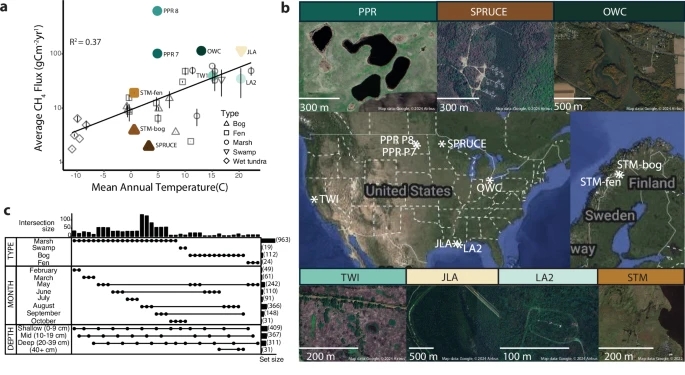On August 8th, two of our Geosciences graduate students, Ujjwal Kharel and Hamza Rehman, had an amazing opportunity
Advances in Understanding of Wetland Methane Production and Emissions
Wed, 04/02/2025 - 8:29amEnvironmental Sciences professor Jorge Villa and his team collaborated on two high-impact studies to advance our understanding of methane production and emissions from wetlands and how we represent these processes in Earth Systems Modeling. Methane is a potent greenhouse gas thought to be responsible for about half of the total global warming effect since preindustrial levels. Despite wetlands representing nearly one-third of global emissions, we still have many questions about how these ecosystems will respond to climate change.
The first study Metabolic interactions underpinning high methane fluxes across terrestrial freshwater wetlands, which appeared in Nature Communications, was lead by a microbiologist team based in Colorado State University, with whom Dr. Villa has worked since 2018. This study revealed that high methane-emitting wetlands exhibit distinct microbial community structures and metabolic interactions that drive methane fluxes. One of the eight core methane cycling genera identified is the Methanoregula, which seems to play a central role as a hub methanogen in microbial networks and is a strong predictor of methane flux. The study also highlights the previously under appreciated fact that methylotrophic methanogenesis is an important pathway contributing to methane production in these ecosystems. These findings present a clearer picture of the specific organisms involved in methane production in wetlands, opening a path for more detailed model representations and hopefully more accurate predictions of methane emissions in climate models.

Figure caption: Freshwater wetlands were examined to determine linkages between microbial communities and predictions of methane flux
The other study ELM-Wet: Inclusion of a Wet-Landunit With Sub-Grid Representation of Eco-Hydrological Patches and Hydrological Forcing Improves Methane Emission Estimations in the E3SM Land Model (ELM), which appeared in the Journal of Advances in Modeling Earth Systems (JAMES), was led by researchers at Ohio State University. This study introduced a new, improved version of the land surface representation in the Energy Exascale Earth System Model (E3SM). E3SM is a state-of-the-art model development and simulation project that investigates energy-relevant science using code optimized for the Department of Energy's advanced computers. This model integrates models of the atmosphere, land, river, ocean, sea ice, and land ice to simulate and project climate changes over decades to centuries. E3SM is designed to address energy-related science challenges, such as water availability, extreme temperatures, energy resource potentials, and sea-level rise. Dr. Villa's work generated critical data that was used to parameterize a newly created version of the land component of ELM that includes wetland-specific processes driven by fluctuations in water levels.

Figure caption: Wet-landunit sub-grid representation. Each column represents a different wetland patch type (WPT) (from 1 to nWPT arbitrary eco-hydrological patch types), where each column has a different water depth adapted to the corresponding WPT
This work, which started in 2020, involved Earth and Energy Sciences PhD students, Robert Bordelon and Diana Taj, and sixteen undergraduate research interns trained in greenhouse gas flux measurements and data analyses. The Environmental Science undergraduate student interns are: Eriell Jenkins, Aaron Gondran, Madeline Moore, Monique Blanchard, Victoria Gomez, Jordan Schouest, Jude Digilormo, Mia Rinaudo, Monique Blanchard, Jordan Stoll, Luke Romero , Benjamin Hymel, Jillian Mina, Mason Marcantel, Théo Huval, and Jacob Deslattes.

Greenhouse Gas Flux Measurement Chamber (Wetland Ecosystem Science Lab photo)

